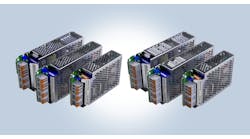The wirelessHART gathering point would be bringing in more than 50 wireless temperature sensors along with other assorted measurements, which would be displayed on the host DCS using Modbus. The gathering point, or WiHART gateway, could also be connected to the asset management system using Ethernet, which would allow the instrument tech to monitor battery life and detect connection issues from the comfort of the shop. But 24 VDC for the gateway and fiber media converters was not especially common or readily available near the hydrocarbon processing area, just those that originated from the ESD System and DCS I/O—two-wire power that was provided per-channel for 4-20 mA I/O and two-wire fieldbus.
Two-wire power that allows instruments to provide a meaningful output—whether a proportional analog 4-20 mA signal or a digital value over Foundation fieldbus (FF)—has been around for decades. Why do we like it so much? Not only does it save us from installing and maintaining field power supplies and the added copper wiring, it allows us to use UPS power based in the control house or rack room module. Thoughtfully engineered and provisioned UPS power is battery-backed-up to sustain its users for 30 minutes or more. They’ll bridge most brown-outs and local power interruptions without any loss of data or control, to the degree pump motors, compressors and their ilk are unaffected.
Bulk 24 VDC power supplies in the DCS and ESD rack area are typically redundant themselves (or should be), with each capable of bearing the entire load should its partner fail. Some employ N+1 schemes that also ensure no single power supply fault will have any impact on two-wire power (or power to the DCS/ESD system computational and I/O backbone, for that matter). The design frequently exerts some effort to supply independent feeds to dual UPS systems, each sourced from independent buses. The robust fault-tolerance of house-sourced two-wire power becomes hard to equal for field-powered instruments or systems.
The difficulty of achieving such robustness for the WiHART gateway and all the associated appliances was less vexing because the wireless measurements were largely indicate-only, nice-to-have diagnostic information for long-term monitoring of equipment health, e.g. heat exchanger fouling. If one day its non-redundant field-based 24-VDC power supply failed, it didn’t seem likely to have any chance of interrupting the continuous process. The plant employed some field-sourced multiplexor boxes for wired temperature sensors that were built with dual DC power supplies, but even these were often powered from the same AC distribution panel. Hence, the I&C engineer could view her WiHART gateway as something akin to the old remote I/O mux box.
One day her assumptions were tested when, curiously, all the wireless instruments, as well as an odd mix of other instruments and a mux, all went bad at once. No one had considered that a gateway fault, or for that matter, a mux malfunction, might produce an alarm flood, but it did. An alarm flood out of nowhere is normally an indication that a process upset is imminent. As the console operators puzzled over what was happening and silenced the dozens of “bad quality” alarms that came in simultaneously, they took stock of where the process stood and whether they were going to shut down. Thankfully, the production of useful chemicals continued, even though a few flows were also “bad” and their control loops had shed to manual. What was going on?
It took a little while, but eventually one of the outside operators noticed that a utility hose draped above a local power panel had drooped and tripped the lever of that panel’s disconnect switch. Every one of the two dozen-odd circuits in the panel were without AC power, which included the gateway, the mux box, assorted Coriolis and magnetic flowmeters, as well as a nuclear level indicator.
Efforts to provide robust power—even for indicate-only measurements—have proven to be worth more consideration. The affected “single points of failure” for the WiHART gateway and the multiplexer were remedied by installing diode-auctioneered DC supplies, which we fed from separate panels. Today, one can even specify and procure small hazardous-area-capable UPS systems with configurable battery backup. With some added effort and cost, robust DC power for field-based I/O can be achieved.





